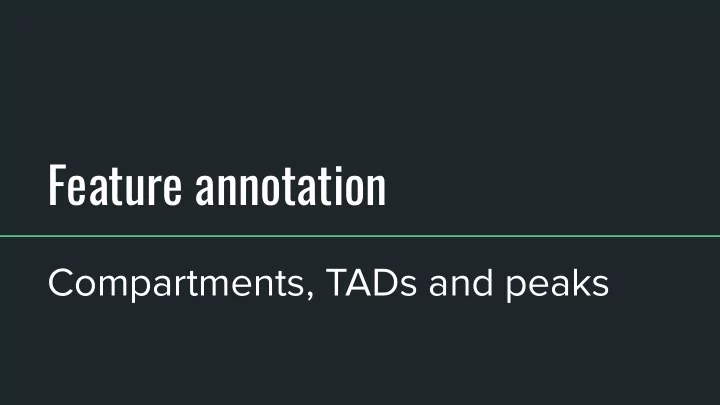

Feature annotation Compartments, TADs and peaks
Compartments
Recap
Learning ● Identify compartments in HiC matrix ● Compartments in plants objectives
Compartments - A compartment: - active regions (euchromatin) - B compartment: - inactive regions (heterochromatin) - Bin sizes 100kb - 1MB - PC1
PCA - Principal Component Analysis - The first eigenvector will give the compartmentalization profile - Positive values indicate one compartment, negative values indicate other compartment - How to tell if A or B?
Correlation with other data - Show first component together with other epigenomic tracks: - Gene content / TE density - Histone modifications: - A: H3K27Ac, H3K4me3 - B: H3K27me3, H3K9me3 - Transcription - RNA seq tracks
Practical - Identify compartments with HiCexplorer
TADs
Recap
Learning ● Identify TADs with HiCExplorer objectives ● Discuss challenges in TAD calling
TADs - TADs are regions with elevated self interaction frequencies - TADs might act as an insulated genomic region that constrains regulatory interactions
TAD calling in HiCexplorer 1. Transform matrix to Z score (subtract mean contact frequency at each distance): make bins more comparable 2. For each bin, calculate average contacts between w upstream and downstrem bins. 3. Repeat for different values of w , and then take the average. 4. Local minima should be boundaries! 5. To double check: compare the distributions of upstream and downstream “diamonds”.
TAD calling challenges - What is a TAD? - TAD-like patterns are often hierarchical and overlapping (subTADs, gene mini domains) - There are aprox. 22 different TAD calling algorithms - Current approaches often not reproducible - Sensible to normalization, bin size, sequencing depth
TAD calling algorithms - Linear score - Directionality Index - Insulation score - TopDom - HiCExplorer - Statistical models - TADbit - Clustering - ClusterTAD - Network analysis - spectral
Practical: - TAD calling with HiCexplorer
Interaction peaks
Recap
Learning ● Identify peaks with HiCCUPS objectives
Peaks and biological features - Enhancer-promoter interactions - CTCF-CTCF and cohesin binding sites - Polycomb bodies - KNOT region (Arabidopsis) - Gene - Gene interactions (Maize)
HICCUPS - Local enrichment over four backgrounds: - Donut - Horizontal - Vertical - Lower left corner - Compare bin contact frequency with average contact frequency of each background
Aggregate Peak Analysis - Analyse the average interaction profile for all peaks - Can be used as QC
Peak calling algorithms - Global enrichment - Fit-HiC - HOMER - HICCUPS - Local enrichment - HICCUPS - HiCExplorer
Practical: - Peak calling with HiCexplorer
Resources: - HiCExplorer: https://hicexplorer.readthedocs.io/ - HiGlass: http://higlass.io/ - Deeptools: https://deeptools.readthedocs.io/en/develop/ - Juicer: https://github.com/aidenlab/juicer/wiki - Collection of hic tools: https://github.com/mdozmorov/HiC_tools
Recommend
More recommend